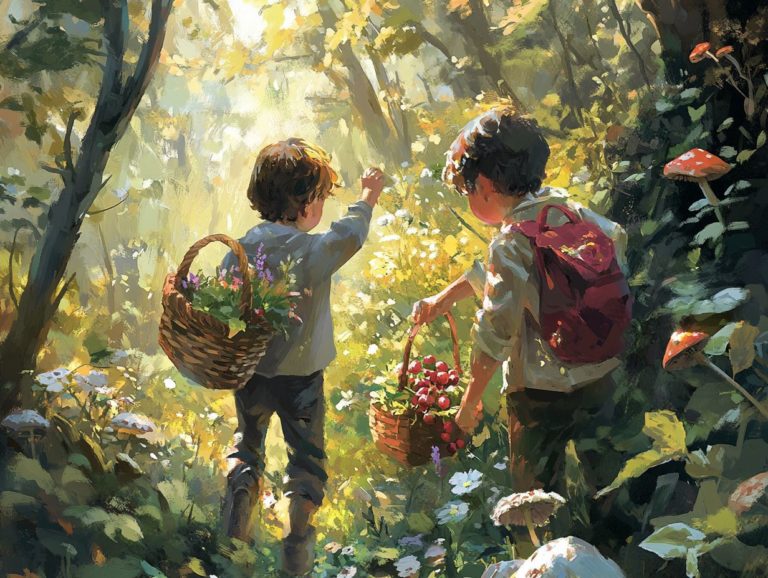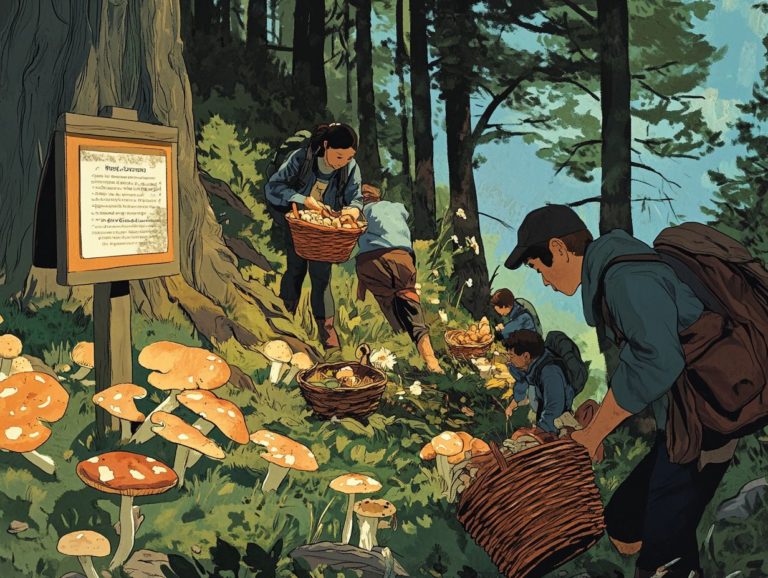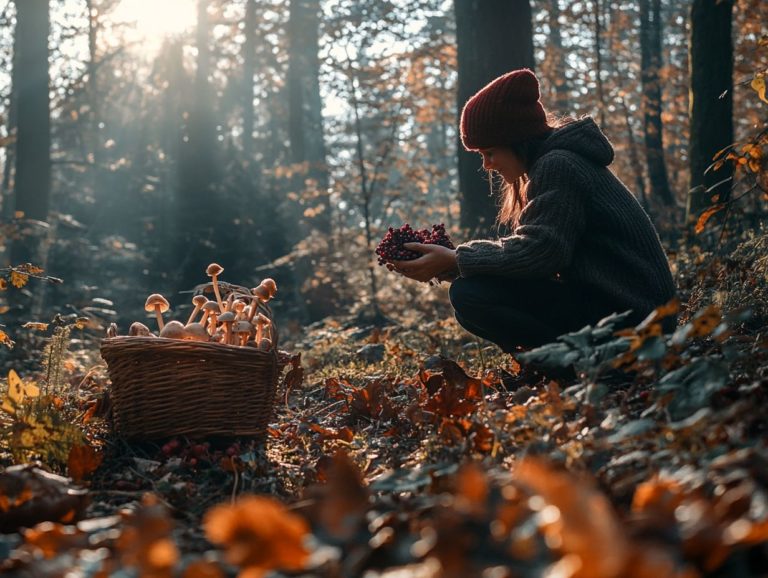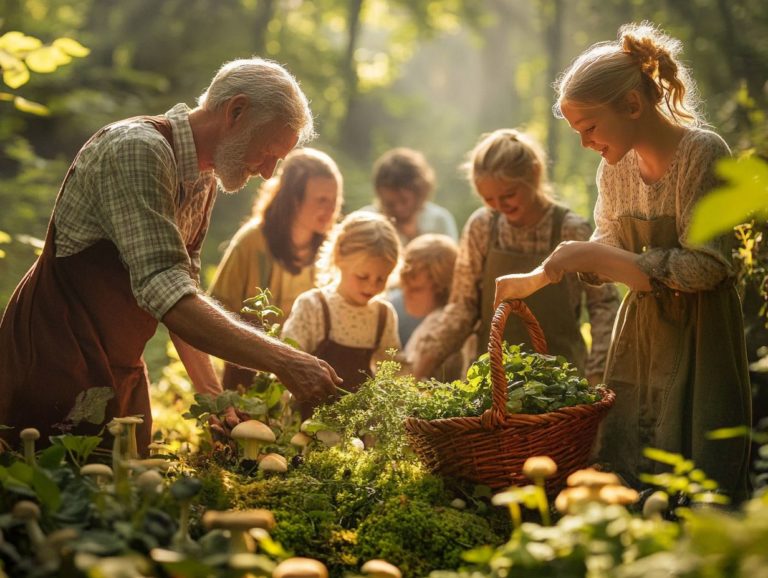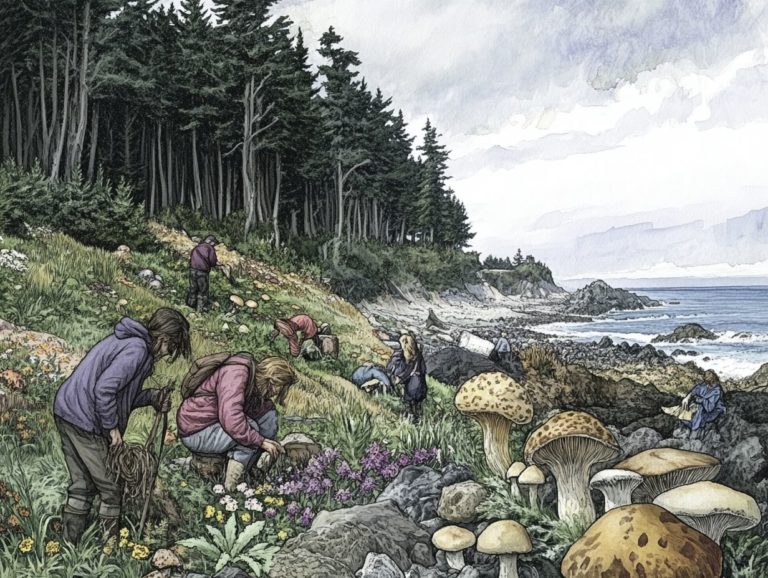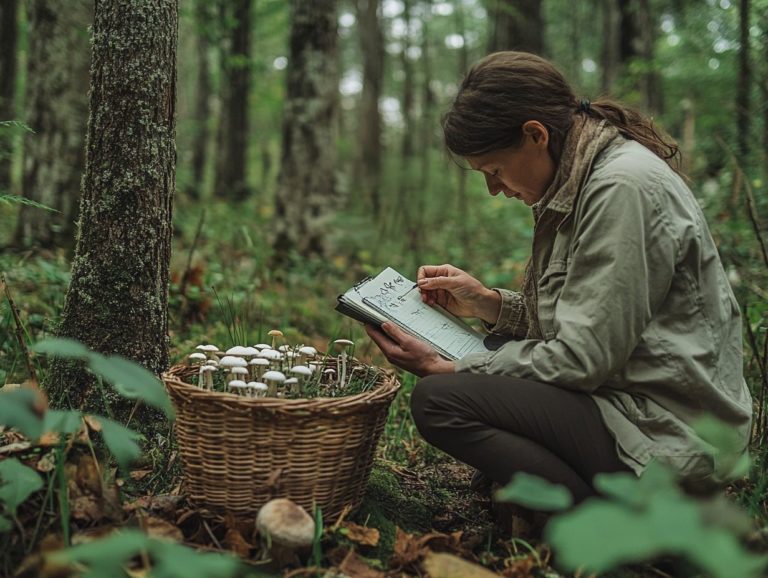Top Foraging Techniques for Edible Flowers
Exploring the world of edible flowers unveils a vibrant array of culinary possibilities, allowing you to elevate your dishes with stunning garnishes or create delightful infusions.
This guide provides everything you need, beginning with how to identify which blooms are safe to eat and the ideal times for foraging them.
Discover essential techniques, important safety precautions, and invaluable tips for harvesting and preserving these floral treasures.
Whether you re a seasoned forager or just curious about this colorful realm, prepare to enhance your culinary repertoire and impress your guests with nature’s exquisite delights.
Contents
- Key Takeaways:
- 1. Identifying Edible Flowers
- 2. Knowing When and Where to Forage
- 3. Proper Equipment and Safety Precautions
- 4. Foraging Techniques for Different Types of Flowers
- 5. Tips for Harvesting and Preserving Edible Flowers
- 6. Cooking with Edible Flowers
- 7. Creating Floral Infusions and Syrups
- 8. Making Edible Flower Salads and Garnishes
- 9. Using Edible Flowers in Baking and Desserts
- 10. Incorporating Edible Flowers in Cocktails and Beverages
- 11. Drying and Storing Edible Flowers
- 12. Common Mistakes to Avoid When Foraging for Edible Flowers
- 13. Ethical Foraging Practices
- 14. Safety Precautions for Foraging in the Wild
- 15. Exploring the World of Edible Flowers
- What Are the Health Benefits of Edible Flowers?
- Frequently Asked Questions
- Top Techniques for Foraging Edible Flowers
- How do I identify edible flowers for foraging?
- When is the best time to forage for edible flowers?
- Where is the best place to forage for edible flowers?
- What tools do I need for foraging edible flowers?
- How do I properly store and prepare foraged edible flowers?
Key Takeaways:
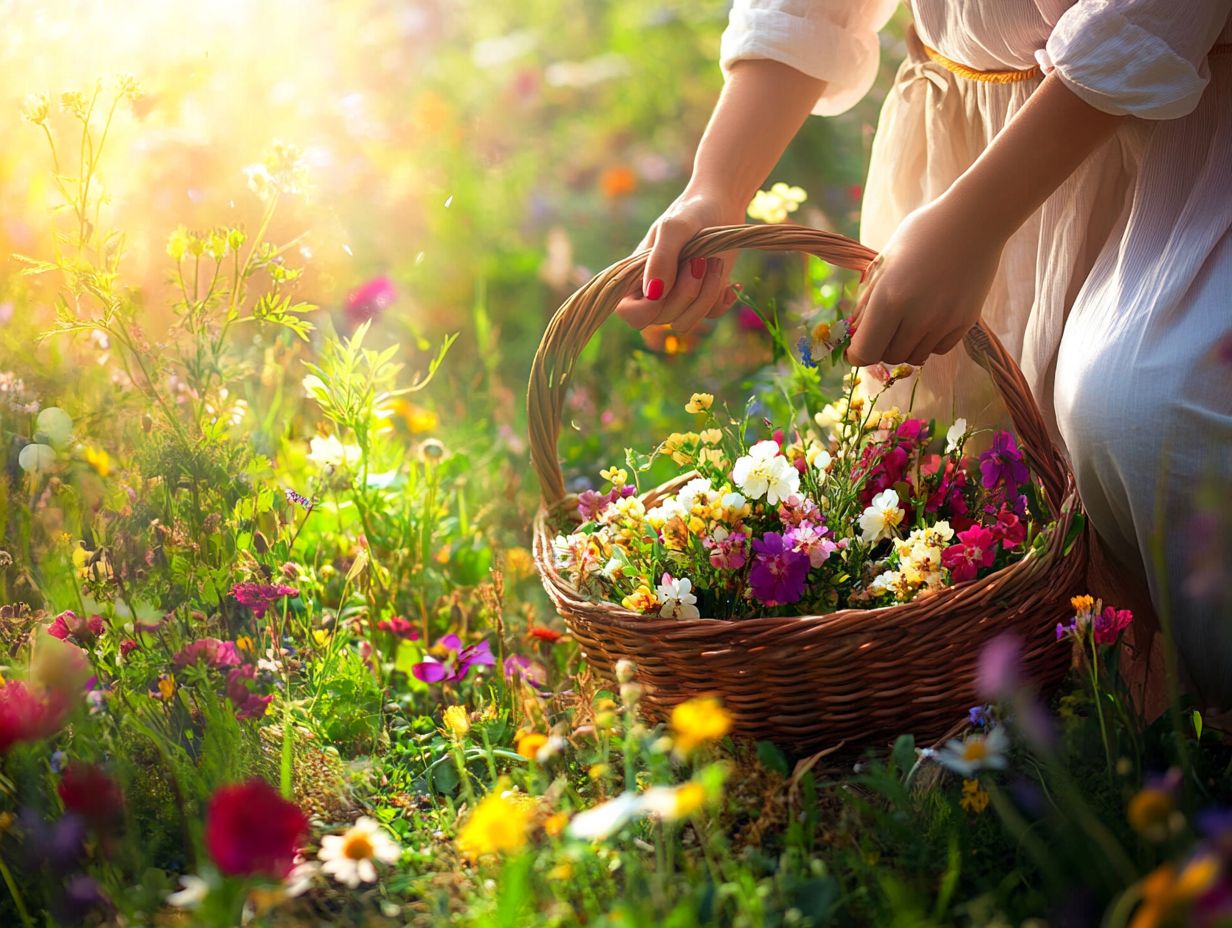
- Proper identification of edible flowers and common plants is crucial before foraging.
- Knowing when and where to forage ensures the availability of fresh and safe edible flowers.
- Using the right equipment and following safety precautions is essential for a successful and safe foraging experience.
1. Identifying Edible Flowers
Knowing how to identify edible flowers opens a world of exciting culinary possibilities for you as a forager or culinary enthusiast. Many of these delicate blooms, like Virginia Bluebells and wild roses, enhance your dishes with their unique flavors while adding a vibrant touch that makes your meals visually appealing and delicious.
When used correctly in various culinary techniques, they can transform savory dishes and serve as delightful floral garnishes. Recognizing these flowers requires careful observation of their features think color, shape, and size along with an understanding of their preferred growing conditions.
For example, milkweed flowers, with their clusters of pinkish-purple blooms, thrive in sunny, open areas, while lilacs, boasting a lovely lilac hue and a strong fragrance, flourish in well-drained soil with plenty of sunlight.
It’s essential to accurately identify these edible varieties, as some lookalikes can be toxic. By educating yourself on visual identifiers and growing habits, you can confidently incorporate these beautiful blooms into your dishes and safely enjoy their myriad flavors.
2. Knowing When and Where to Forage
Understanding when and where to forage for edible flowers is essential for maximizing your harvest. Different species have their own seasonal rhythms, with spring ephemerals flowers that bloom in spring and only last for a short time like Trout Lily and Beach Pea popping up early in the year.
These flowers offer unique flavors that can elevate various dishes. As summer approaches, you ll encounter vibrant blooms such as Nasturtiums and Calendula, which flourish in gardens and wild meadows alike, adding color and a hint of spice to your salads and desserts.
Fall brings its own delightful offerings, like Wild Asters and Goldenrod, which not only enhance soups but also introduce intriguing flavors for those willing to experiment in the kitchen.
When you head out foraging, seek sunny meadows or pristine woodland edges, and remember to practice sustainable harvesting techniques. It s also wise to familiarize yourself with local regulations regarding foraging, as some areas impose restrictions to safeguard native species and ecosystems.
3. Proper Equipment and Safety Precautions
Equipping yourself with the right tools and understanding foraging safety precautions is essential when seeking edible flowers. This knowledge gives you the power to confidently identify plants like Creeping Bellflower and Jewelweed, all while ensuring the safe consumption of your wild food harvest.
A reliable pair of scissors is a must for making clean cuts, especially when delicately extracting blooms or roots from their natural environment. Durable gloves serve a dual purpose: they protect your hands from thorns and irritants while also guarding against poisonous plants.
And don t forget a sturdy basket; it s your best friend for carrying your finds without bruising them during your adventure. The importance of foraging safety cannot be overstated.
Being able to distinguish between edible and potentially toxic plants is crucial for anyone venturing into the wild. Bringing along a field guide or consulting with an experienced expert adds an invaluable layer of safety, offering guidance and reassurance as you explore the rich diversity of nature’s bounty.
Are you ready to start foraging today? Dive into the enchanting world of edible flowers and share your experiences with these beautiful culinary delights!
4. Foraging Techniques for Different Types of Flowers
Mastering foraging techniques for various edible flowers can elevate your culinary skills. You’ll discover unique flavors from plants like Elderflowers and Dandelions. You’ll also appreciate their culinary applications in many dishes.
These techniques require awareness of seasonality and growth patterns of flowers. This ensures you harvest them at peak flavor. For delicate blossoms like violets or chamomile, use a gentle pinch and twist method to preserve their integrity. For tougher stems, sharp, clean scissors are essential to minimize bruising.
It’s crucial to recognize the distinct flavors of each flower. Nasturtiums bring a peppery punch, while calendula adds subtle sweetness. Incorporating these versatile ingredients into salads, teas, or desserts can transform even the simplest recipes into extraordinary creations.
5. Tips for Harvesting and Preserving Edible Flowers
Harvesting and preserving edible flowers requires careful attention to detail. These delicate blooms can quickly lose their colors and flavors. It’s vital to use proper cooking methods to maintain their quality for future dishes.
To achieve the best flavor and texture, aim to harvest early in the morning when the flowers are open and cool. This timing minimizes moisture loss and enhances taste. When handling these fragile petals, use gentle movements to avoid pressure that could bruise them.
After harvesting, don t miss out! Try drying or freezing to extend their shelf life while keeping their unique profile. Proper preservation maintains the delicate interplay of natural aromas and flavors, ensuring they elevate your culinary creations.
6. Cooking with Edible Flowers
Cooking with edible flowers opens up exciting culinary opportunities. Imagine enhancing your dishes with vibrant colors and unique flavors that captivate the senses.
By experimenting with various cooking methods, you can transform a simple meal into a gourmet experience. For instance, think about infusing lavender into oils or butters for your roasted vegetables or grilled meats. Imagine whipping up a sauce with nasturtium petals that not only tastes fantastic but also looks amazing!
Garnishing salads with vibrant blooms like pansies or violets adds a striking pop of color that sparks curiosity. With each technique you explore, the charm of edible flowers unfolds, inviting you to appreciate the delicacy and artistry they bring to your table.
7. Creating Floral Infusions and Syrups
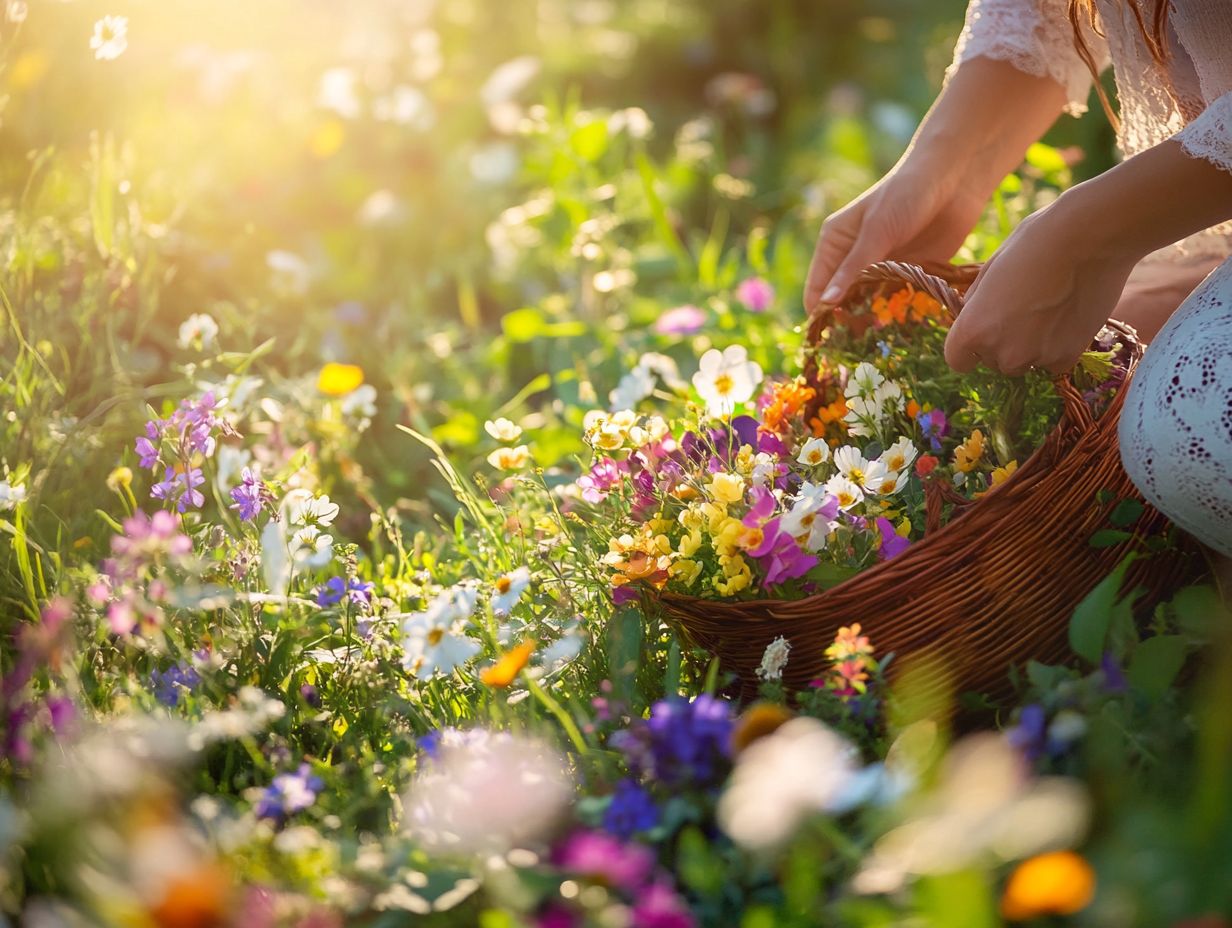
Creating floral infusions and syrups with edible flowers not only enhances your beverages and dishes but also captures the essence of blooms like Bee Balm and Wild Mustard Flowers. This practice provides a flavor profile that can elevate your culinary creations.
To embark on this enchanting journey, choose your flowers carefully. Ensure they are organically grown and free from pesticides. Start by gently rinsing the blooms to remove any dirt or small insects.
Next, select your base liquid: water or sugar syrup work wonderfully, depending on your goal. For lavender, the infusion offers a soothing aroma. In contrast, hibiscus brings a tangy, vibrant flavor that invigorates any drink.
Once the flowers steep in your chosen liquid, let them rest for several hours before straining. When stored in a cool, dark place, these infusions can last for weeks.
Meanwhile, the syrup can be drizzled over cakes or pancakes for an elegant touch. Floral infusions serve as delightful enhancements to cocktails or refreshing teas.
8. Making Edible Flower Salads and Garnishes
Making edible flower salads and garnishes is a creative way to add color to your meals. Flowers like Lilacs and Day Lily can enhance both taste and presentation. This transformation turns ordinary dishes into delicious dishes that impress both the eyes and the palate.
By exploring the delicate notes of various flowers, you can elevate a simple salad to a gourmet experience. Consider pairing these blossoming gems with a mix of peppery arugula or crisp romaine lettuce, along with fresh herbs like basil or mint for additional flavor. For a refreshing twist, think about combining the flowers with seasonal fruits such as peaches or berries, allowing their natural sweetness to beautifully complement the floral essence.
Presentation is key. Arranging the flowers thoughtfully can transform a basic bowl into an artistic centerpiece, making any meal feel like a special occasion. Whether served alongside a light vinaigrette or a creamy dressing, these exquisite salads are sure to impress.
9. Using Edible Flowers in Baking and Desserts
Incorporating edible flowers into your baking and desserts can truly elevate your creations, adding an artistic flair and unique flavors. Imagine creating stunning desserts with Elderflowers and Milkweed. These ingredients will not only look amazing but also taste incredible!
But it s not just about looks. These flowers can introduce delicate notes to your cakes think of lavender s calming aroma enhancing a lemon shortcake or the sweet floral hints of hibiscus brightening a tart. Regarding pastries, vibrant pansies and nasturtiums can infuse your cream puffs or clairs with their eye-catching colors and mild, peppery flavors.
The techniques at your disposal are varied and exciting. You can infuse syrups for glazing or crystallize blooms for the perfect garnish. This ensures that sweenness and fragrance harmonize beautifully in your desserts. By focusing on flavor compatibility, you can effortlessly transform ordinary treats into unforgettable masterpieces that delight the palate and captivate the eye.
10. Incorporating Edible Flowers in Cocktails and Beverages
Incorporating edible flowers into your cocktails and beverages not only elevates their visual appeal but also introduces distinct flavors that can transform a simple drink into a refreshing and sophisticated experience. This makes them an excellent addition to any gathering or celebration.
By selecting the right flowers like lavender, hibiscus, or pansies you can craft delightful infusions that pair beautifully with spirits such as gin, vodka, or rum. For example, steeping the sweet notes of hibiscus in a simple syrup can add a vibrant twist to a classic margarita, while fresh lavender beautifully complements gin for a soothing summertime sipper.
For garnishing, a sprinkle of edible flower petals atop your drink creates a stunning visual centerpiece, turning each cocktail into an eye-catching masterpiece. Seasonal cocktails also gain a new level of elegance. Picture yourself sipping a refreshing elderflower spritz adorned with delicate rose petals during a spring garden party, or enjoying a pumpkin spice martini embellished with orange marigolds at a cozy autumn gathering.
11. Drying and Storing Edible Flowers
Drying and storing edible flowers is essential for anyone who enjoys foraging or culinary adventures. By mastering these techniques, you can preserve the beauty and flavor of blooms like Meadowsweet and Wild Carrot, allowing you to incorporate them into your culinary creations year-round.
To effectively dry these delicate flowers, consider gentle methods such as air drying, using a dehydrator, or placing them between sheets of absorbent paper. Aim for a drying environment that s cool, dark, and well-ventilated, steering clear of direct sunlight to maintain those vibrant colors and essential oils.
Once dried, it s vital to store the flowers in airtight containers in a cool, dry place to keep their flavor and aroma intact. With these dried treasures on hand, you can enhance your cooking effortlessly, infuse them in teas, or use them as eye-catching garnishes, adding both visual flair and unique flavors to a wide array of dishes.
12. Common Mistakes to Avoid When Foraging for Edible Flowers
Foraging for edible flowers can be an incredibly rewarding experience. However, it s essential to avoid common mistakes that could lead to misidentifying toxic plants or consuming something unsafe. Such errors put both your health and your foraging enjoyment at risk.
To safely navigate this adventure, prioritize thorough research and familiarize yourself with local flora. Using apps on your phone, engaging with field guides, or even joining a local foraging group can significantly boost your knowledge and confidence.
Keep a journal and snap photographs of plants in their natural habitat. These can aid in confirming your identifications. Always exercise caution by avoiding plants that resemble well-known edibles. Many toxic species have a knack for mimicking their appearance.
Take a moment to observe your surroundings. Refrain from harvesting near polluted areas to ensure that the food you forage is both safe and delicious. By following these precautions, you can truly savor the bountiful gifts that nature has to offer.
13. Ethical Foraging Practices
Practicing ethical foraging is vital for the sustainability of ecosystems and the preservation of wild food sources. This helps ensure that future generations can savor the beauty and flavors of edible flowers while honoring nature and its delicate balance.
By following some fundamental principles, you can significantly contribute to environmental health. Harvest only what you need and be mindful never to deplete local plant populations. When you pick wildflowers, leave at least one-third of the blooms intact to allow insects and wildlife to flourish.
As you navigate your foraging adventures, avoid fragile or heavily trafficked areas to respect local habitats. Familiarizing yourself with the specific flora and fauna elevates your experience, deepening your appreciation for the diverse ecosystems around you.
14. Safety Precautions for Foraging in the Wild
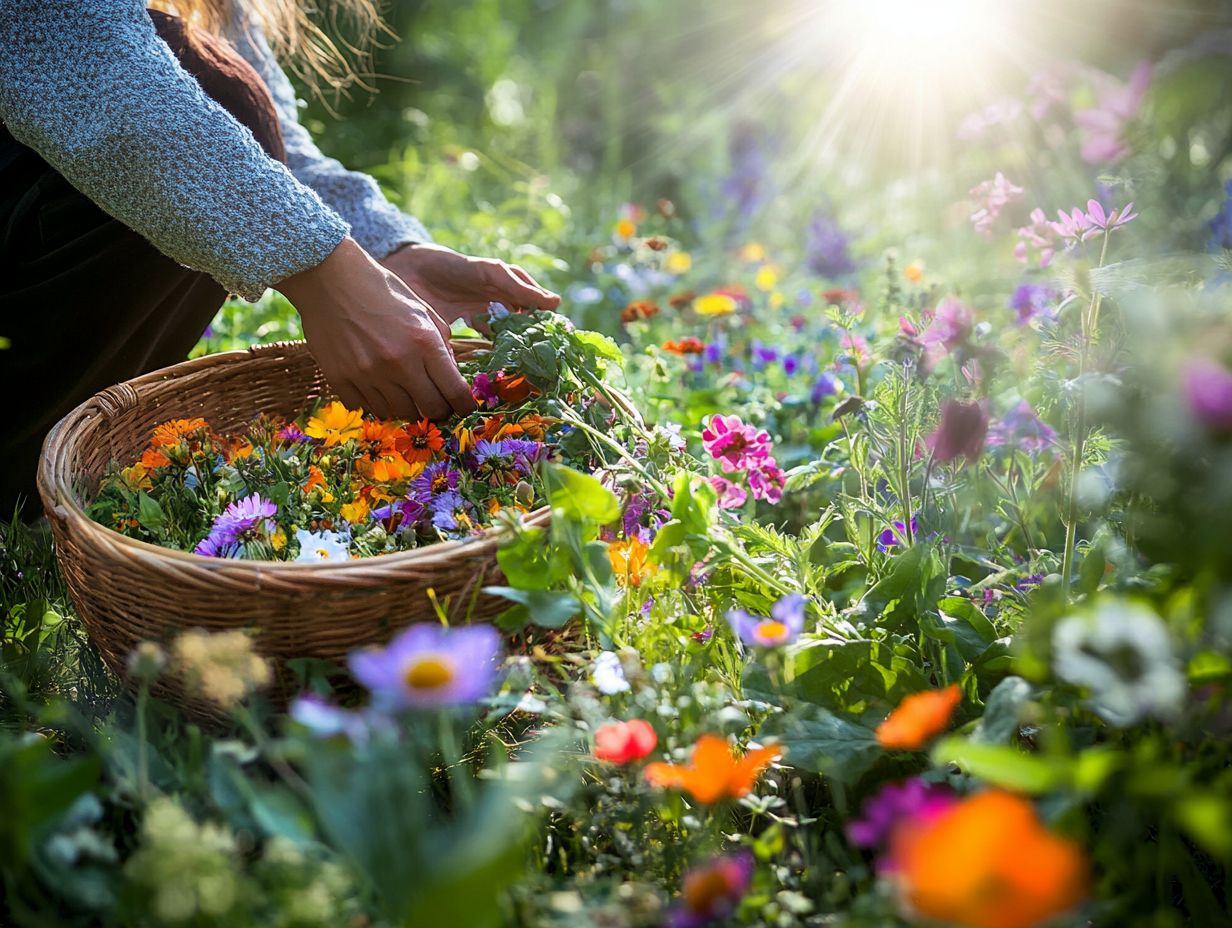
Implementing safety precautions while foraging in the wild is essential for ensuring that your quest for edible flowers is both positive and enriching. This approach helps you spot plants confidently and practice safe consumption without the looming fear of harmful effects.
To enhance your safety during these adventures, always go foraging with a partner. Not only does this foster accountability, but it also enriches your ability to share knowledge and make informed decisions about the plants you encounter.
Carrying a reliable field guide is invaluable for accurately identifying flora, as some plants have toxic look-alikes. It’s crucial to avoid areas that may be polluted, like roadside locations or industrial sites, where plants could have absorbed harmful contaminants.
Staying informed about local flora and their potential hazards can further elevate your experience, fostering a responsible and enjoyable relationship with nature.
15. Exploring the World of Edible Flowers
Exploring the world of edible flowers reveals a captivating array of flavors, colors, and culinary applications that can elevate your meals. Imagine foraging seasonally, from the vibrant wild roses of summer to the delicate milkweed flowers of spring, while gaining a profound appreciation for nature’s bounty through a wild food guide.
By venturing into this enchanting realm, you can learn to incorporate these blossoms into salads, teas, and desserts, transforming everyday dishes into unforgettable culinary experiences.
For those keen to broaden their knowledge, resources like field guides or engaging local workshops offer invaluable insights on identifying edible species and their ideal harvesting times. With a spirit of experimentation and a thirst for learning, you can enhance your cooking while cultivating a genuine connection with the earth’s natural offerings.
Don t miss the chance to explore nature s kitchen! Grab your field guide and step into the vibrant world of edible flowers today!
What Are the Health Benefits of Edible Flowers?
Edible flowers look beautiful and offer numerous health benefits. They can enhance your overall well-being when added to a balanced diet.
These colorful flowers pack vitamins A and C, along with minerals like calcium and iron. These nutrients can boost your immune system and promote radiant skin.
Nasturtiums, for example, help fight germs and support digestion. By incorporating blossoms like violets or marigolds into your salads, teas, or as elegant garnishes, you can easily elevate your nutritional intake.
This simple addition not only enhances the taste and presentation of your meals but also offers a delightful way to tap into nature s pharmacy each day.
How Can One Incorporate Edible Flowers into Their Diet?
Incorporating edible flowers into your diet is a delightful way to elevate your meals. They provide visual appeal, unique flavors, and essential nutrients.
These vibrant flowers can easily improve your meals. Imagine tossing nasturtiums or pansies into a green salad; you’ll add a splash of color and a peppery bite.
Picture yourself sipping on herbal tea infused with orchids, which lends a subtle sweetness for a lovely afternoon treat. If you’re feeling adventurous, try adding edible petals like lavender or calendula to your roasted vegetables or grain bowls.
This aromatic twist can transform an ordinary dish into something truly extraordinary while reminding you of the exquisite beauty that nature has to offer.
What Are the Most Common Edible Flowers Found in North America?
North America offers a delightful array of common edible flowers, such as dandelions, beach pea, and bee balm. Each of these blossoms presents unique flavors and culinary possibilities, making them favorites among foragers and home cooks.
These flowers provide a splendid opportunity to elevate your dishes with vibrant color and enticing taste, whether you’re crafting a salad or a dessert. Dandelions, with their mildly bitter greens and sweet yellow petals, are perfect for brewing tea and adding a cheerful touch to your salads.
If you venture to coastal regions, you ll find beach peas, whose delicate purple flowers lend a sweet, pea-like flavor to your creations. Let s not forget bee balm, which infuses a refreshing, minty essence that complements both savory and sweet dishes beautifully.
For the adventurous at heart, exploring local foraging spots can reveal even more edible blossoms, transforming a simple meal into a delightful culinary adventure.
How Can One Identify Poisonous Flowers While Foraging?
Identifying poisonous flowers while foraging is crucial for your safety. You need a keen eye to spot differences and do your homework before eating wild food.
As you embark on your journey into the realm of wild edibles, familiarize yourself with key visual indicators, such as flower color, leaf shape, and growth patterns. Be particularly cautious of flowers like foxglove, deadly nightshade, and oleander, which are commonly found in various regions and pose significant health risks.
Utilizing field guides can assist you in recognizing these dangerous species while enriching your overall foraging knowledge. Consider engaging with local foraging workshops; they offer invaluable insights and hands-on experience, reinforcing the importance of education. This ensures that your foraging adventures are not only safe but also rewarding.
What Are the Best Seasons for Foraging Edible Flowers?
Understanding the best seasons for foraging edible flowers is crucial for maximizing your yield. Foraging means searching for and collecting wild plants that are safe to eat.
In spring, it’s amazing to find vibrant blooms like violets and dandelions! They offer a delightful hint of sweetness to your salads and desserts.
As summer rolls in, you can discover the bright hues of nasturtiums and lavender. These flowers are perfect for infusing oils or garnishing your dishes.
When fall arrives, goldenrods and chrysanthemums come into play. They add unique flavors and colors to your meals.
Even winter has hidden treasures, with hardy herbs that flower in milder climates.
Plan your outings around the peak blooming times of each flower. Research local growing conditions and seasonal variations to capture the freshest selections available.
Frequently Asked Questions
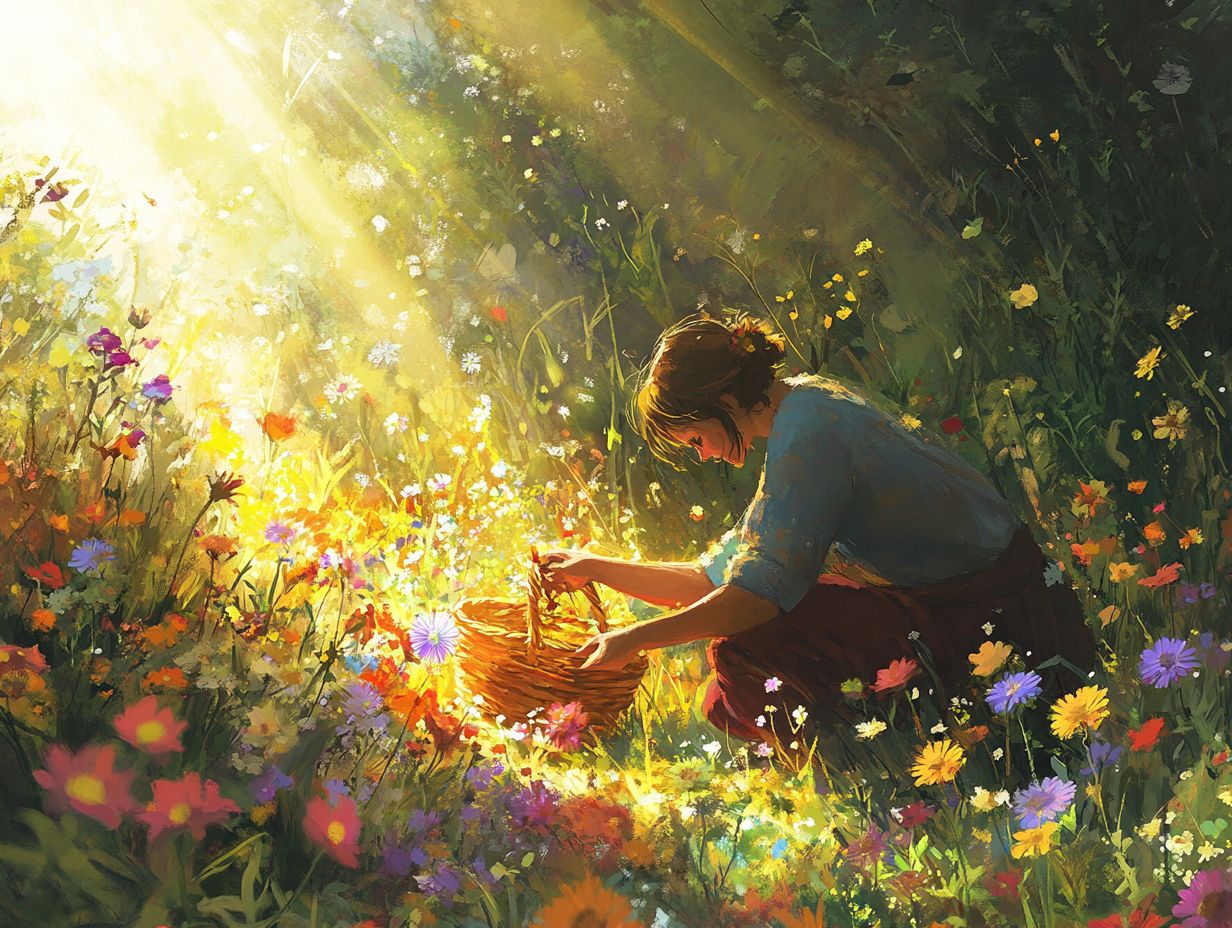
Top Techniques for Foraging Edible Flowers
Some of the best techniques include:
- Identifying the right flowers
- Knowing when and where to forage
- Using proper tools
- Properly storing and preparing the flowers for consumption
How do I identify edible flowers for foraging?
Identify edible flowers by:
- Researching and studying different flower species
- Consulting with experts
- Using field guides or smartphone apps
When is the best time to forage for edible flowers?
The best time to forage is usually in the morning when the flowers are at their freshest and most fragrant. Spring and summer are ideal for blooming flowers.
Where is the best place to forage for edible flowers?
The best places to forage are natural and pesticide-free areas, like:
- Meadows
- Forests
- Gardens
Avoid areas that may have been contaminated with chemicals or pollutants.
What tools do I need for foraging edible flowers?
Essential tools include:
- Garden shears or scissors
- A basket or bag for collecting
- Gloves for protection
A guide or reference material for proper identification can also be very helpful.
How do I properly store and prepare foraged edible flowers?
Store foraged edible flowers in a cool, dry place and consume them within a few days for maximum freshness. Before eating, properly clean and remove any insects or debris.
Edible flowers are great in salads, teas, or as a garnish for various dishes.
Get ready to explore and enjoy the delicious world of edible flowers!

